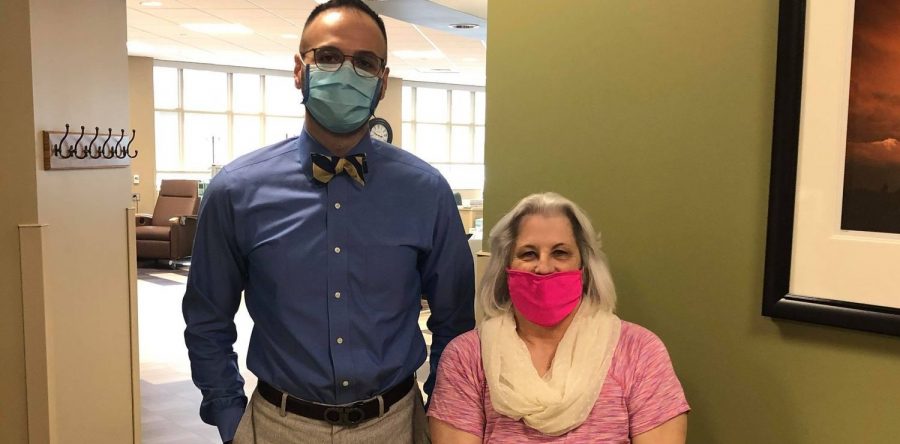It was the middle of August in 2018, just another normal morning for Brenda Rojas. The Garden City paraprofessional was getting ready for work when she happened to feel a lump in her left breast. Brenda had an upcoming appointment scheduled with her primary care provider, who suggested she go ahead and get her yearly mammogram and a biopsy at the Breast Center at St. Catherine Hospital.
What came back was the diagnosis of triple-negative breast cancer. “I just started crying. I was at work, during lunch and just broke down and cried. I left and went to my sister’s work, and we cried. I was thinking holy crud, this really didn’t happen to me, did it? Basically I was kind of numb. My doctor told me that Heartland Cancer Center will be calling and sure enough within two hours, I got a call. That day I started praying heavy. And I truly, truly believe that helped too. I’ve had some rough times, but honestly by that night I was like you know what, I'm going to try to remain positive, deal with whatever this is, and I'm going to be strong about it. I've got to.”
Triple-negative breast cancer is cancer that tests negative for estrogen and progesterone receptors, and excess HER2 protein, meaning the growth of the cancer is not fueled by hormones. This type of breast cancer occurs in about 10 to 20 percent of diagnosed breast cancers and can be more aggressive and difficult to treat.
Brenda, however, is no stranger to handling setbacks and tragedies in life. From losing her husband at a young age from a massive heart attack, watching her mother battle lung cancer, only to go into remission for a few years, before passing away, to her granddaughter being born 11 weeks early. Brenda understood the fight that was about to begin.
Brenda saw Dr. Anis Toumeh from Heartland Cancer Center to start the discussion of treatment options. They decided to try to shrink the tumor ahead of surgery. She was set up to have 16 chemotherapy treatments, 12 weekly, with the last four every other week.
“Dr. Toumeh was really reassuring. Everybody at Heartland – the nurses, even the receptionists, all were so supportive and encouraging,” said Brenda. She started her first chemotherapy treatment right away. “And, by the second one, believe it or not, in a short week, you could see the lump protruding through my shirt. It grew. Dr. Toumeh looked at it and said, I don’t think we’re going to do chemo today. I think we’re going to have to have that removed.”
Brenda had a mastectomy of her left breast in October of 2018. After recovering, she was back at it with her chemotherapy treatments and all was going well, until she got to the last four treatments. “It was really harsh. I had some nausea, bad sores in my mouth, lost my hair, and I hurt. I had to have fentanyl for what seemed like the last two months of treatment because I hurt so bad. I’d wake up, I couldn’t roll over on my left side, it was just harsh.” At times, opioids are used to help treat moderate to severe pain. They are often a necessary part of a pain relief plan for cancer patients.
Brenda waited until after her treatments were complete to have her right breast removed. She chose not to have reconstructive surgery. “It just wasn’t important to me to have reconstructive surgery. I’m not saying a person is wrong for wanting breasts, I just personally elected not to. I don’t feel like not having them takes anything away from who I am. I was more concerned about getting healthy and not having to worry about healing and recovering from surgery or treatment,” said Brenda.
A year later from her last chemotherapy treatment, Brenda sees Dr. Toumeh every six months. Her latest scan looked great, her hair has grown back and she feels good. “I tell people to think positive and try to keep a positive attitude. Those last four treatment were about to do me in, because I felt so bad, but I kept trying to focus on the positive. It’s ok to be sad and to be down, but don’t let it keep you there. Remaining positive and early detection are so key. It’s so important to get your regular mammogram and do the breast self-checks at home.”
Brenda added, “having my treatments here at Heartland Cancer Center, close to home, was great. You don’t have the wear and tear on your body by traveling far and you can come home to your own bed. Plus, I had the support of my family and they would lift my spirits. I had a real good support system and that really helped.” Evidence has proven that going through cancer treatments near loved ones and close to home have improved outcomes. Heartland Cancer Center offers complete cancer care that includes chemotherapy, radiation therapy, financial counseling and other supportive services, all at a state of the art facility.
October is National Breast Cancer Awareness Month. The pink you see around you in your daily life is a reminder to get yourself checked. Breast cancer statistics show that monthly self-exams are important as well as getting an annual mammogram after the age of 40. 1 in 8 women and 10 percent of men will develop breast cancer.
###



2 Responses